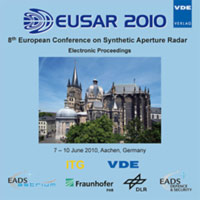Spaceborne to UAV Bistatic Radar System for High-resolution Imaging and Autonomous Navigation
Conference: EUSAR 2010 - 8th European Conference on Synthetic Aperture Radar
06/07/2010 - 06/10/2010 at Aachen, Germany
Proceedings: EUSAR 2010
Pages: 4Language: englishTyp: PDF
Personal VDE Members are entitled to a 10% discount on this title
Authors:
Rodriguez-Cassola, Marc; Younis, Marwan; Krieger, Gerhard (Microwaves and Radar Institute, German Aerospace Center (DLR), 82234 Wessling, Germany)
Oswald, Michael (Astrium GmbH Satellites, Military Programs, 88039 Friedrichshafen, Germany)
Monte, Luca del (European Space Agency, Security Strategy and Partnership Development Office, 75738 Paris, France)
Abstract:
Bistatic radars offer several advantages when compared to their monostatic counterparts. In addition to increased performance, sensitivity, coverage and revisit times, all of them parameters which are mainly dependent on their spatial configuration, bistatic radars offer the objective advantage of being more robust to jamming, since the receiver operates as a mere passive system. The proposed system consists of a spaceborne radar transmitter illuminating an area of interest and one or several radar receivers mounted on a UAV to perform a two-goal mission: a) help autonomous navigation of the UAV by performing the sense and avoid function, and b) perform surveillance of the overflown area using high-resolution remote sensing techniques. Although the requirements for these significantly different tasks might seem distant, having a spaceborne transmitter ensures that the coverage needed for both purposes is achievable. The system can provide a cheap and robust manner for enabling global UAV flight, while enabling continuous all-weather imaging capabilities.


